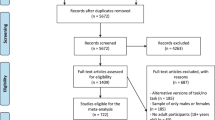Abstract
The Iowa gambling task (IGT; Bechara, Damasio, Damasio, & Anderson, 1994) was developed to simulate real-life decision making under uncertainty. The task has been widely used to examine possible neurocognitive deficits in normal and clinical populations. Busemeyer and Stout (2002) proposed the expectancy-valence (EV) model to explicitly account for individual participants’ repeated choices in the IGT. Parameters of the EV model presumably measure different psychological processes that underlie performance on the task, and their values may be used to differentiate individuals across different populations. In the present article, the EV model is extended to include both fixed effects and subject-specific random effects. The mixed-effects EV model fits the nested structure of observations in the IGT naturally and provides a unified procedure for parameter estimation and comparisons among groups of populations. We illustrate the utility of the mixed-effects approach with an analysis of gender differences using a real data set. A simulation study was conducted to verify the advantages of this approach.
Similar content being viewed by others
References
Bechara, A., Damasio, A. R., Damasio, H., & Anderson, S. W. (1994). Insensitivity to future consequences following damage to human prefrontal cortex. Cognition, 50, 7–15.
Bechara, A., & Damasio, H. (2002). Decision-making and addiction (Part I): Impaired activation of somatic states in substance-dependent individuals when pondering decisions with negative future consequences. Neuropsychologia, 40, 1675–1689.
Boeka, A. G., & Lokken, K. L. (2006). The Iowa gambling task as a measure of decision making for women with bulimia nervosa. Journal of the International Neuropsychological Society, 12, 741–745. doi:10.10170S1355617706060887
Bolla, K. I., Eldreth, D. A., Matochik, J. A., & Cadet, J. L. (2004). Sex-related differences in a gambling task and its neural correlates. Cerebral Cortex, 14, 1226–1232. doi:10.1093/cercor/bhh083
Busemeyer, J. R., & Stout, J. C. (2002). A contribution of cognitive decision models to clinical assessment: Decomposing performance on the Bechara gambling task. Psychological Assessment, 14, 252–262.
Cohen, J. (1988). Statistical power analysis for the behavioral sciences. Mahwah, NJ: Erlbaum.
Davis, C., Patte, K., Tweed, S., & Curtis, C. (2007). Personality traits associated with decision-making deficits. Personality & Individual Differences, 42, 279–290. doi:10.1016/j.paid.2006.07.006
Hoffman, L., & Rovine, M. J. (2007). Multilevel models for experimental psychologists: Foundations and illustrative examples. Behavior Research Methods, 39, 101–117.
Isella, V., Mapelli, C., Morieli, N., Pelati, O., Franceschi, M., & Appollonio, I. M. (2008). Age-related qualitative and quantitative changes in decision making ability. Behavioral Neurology, 19, 59–63.
Marsh, H. W., & Hocevar, D. (1985). Application of confirmatory factor analysis to the study of self-concept: First- and higher-order factor models and their invariance across groups. Psychological Bulletin, 97, 562–582.
O’Neill, R. (1971). Algorithm AS 47: Function minimization using a simplex procedure. Applied Statistics, 20, 338–345.
Pinheiro, J. C., & Bates, D. M. (1995). Approximations to the loglikelihood function in the nonlinear mixed-effects model. Journal of Computational & Graphical Statistics, 4, 12–35.
Pinheiro, J. C., & Bates, D. M. (2000). Mixed-effects model in S and S-Plus. New York: Springer.
R Development Core Team (2006). R: A language and environment for statistical computing [Computer software and manual]. Vienna: R Foundation for Statistical Computing.
Roediger, H. L., III, & McDermott, K. B. (1995). Creating false memories: Remembering words not presented in lists. Journal of Experimental Psychology: Learning, Memory, & Cognition, 21, 803–814.
Rouder, J. N., Lu, J., Speckman, P. L., Sun, D., & Jiang, Y. (2005). A hierarchical model for estimating response time distributions. Psychonomic Bulletin & Review, 12, 195–223.
SAS Institute, Inc. (2004). SAS/STAT user’s guide (Version 9.1). Cary, NC: Author.
Sheu, C.-F., Chen, C.-T., Su, Y.-H., & Wang, W.-C. (2005). Using SAS PROC NLMIXED to fit item response theory models. Behavior Research Methods, 37, 202–218.
Sheu, C.-F., Lee, Y.-H., & Shih, P.-Y. (2008). Analyzing recognition performance with sparse data. Behavior Research Methods, 40, 722–727.
Stockard, J., O’Brien, R. M., & Peters, E. (2007). The use of mixed models in a modified Iowa gambling task and a prisoner’s dilemma game. Judgment & Decision Making, 2, 9–22.
Stout, J. C., Busemeyer, J. R., Lin, A., Grant, S. J., & Bonson, K. R. (2004). Cognitive modeling analysis of the decision-making processes used by cocaine abusers. Psychonomic Bulletin & Review, 11, 742–747.
van den Bos, R., Lasthuis, W., den Heijer, E., van der Harst, J., & Spruijt, B. (2006). Toward a rodent model of the Iowa gambling task. Behavior Research Methods, 38, 470–478.
Verdejo-Garcia, A., Benbrook, A., Funderburk, F., David, P., Cadet, J. L., & Bolla, K. I. (2007). The differential relationship between cocaine use and marijuana use on decision-making performance over repeat testing with the Iowa gambling task. Drug & Alcohol Dependence, 90, 2–11. doi:10.1016/j.drugalcdep.2007.02.004
Wetzels, R., Vandekerckhove, J., Tuerlinckx, F., & Wagenmakers, E.-J. (2008, July). Bayesian parameter estimation in the expectancy valence model of the Iowa gambling task. Paper presented at the 41st Mathematical Psychology Meeting, Washington, DC.
Wolfinger, R. D. (1999). Fitting nonlinear mixed models with the new NLMIXED procedure. In Proceedings of the 24th Annual SAS Groups International Conference (SUGI24) (Paper 287). Gary, NC: SAS Institute.
Yechiam, E., Busemeyer, J. R., Stout, J. C., & Bechara, A. (2005). Using cognitive models to map relations between neuropsychological disorders and human decision making deficits. Psychological Science, 16, 973–978. doi:10.1111/j.1467-9280.2005.01646.x
Author information
Authors and Affiliations
Corresponding author
Rights and permissions
About this article
Cite this article
Cheng, CP., Sheu, CF. & Yen, NS. A mixed-effects expectancy-valence model for the Iowa gambling task. Behavior Research Methods 41, 657–663 (2009). https://doi.org/10.3758/BRM.41.3.657
Received:
Accepted:
Published:
Issue Date:
DOI: https://doi.org/10.3758/BRM.41.3.657




